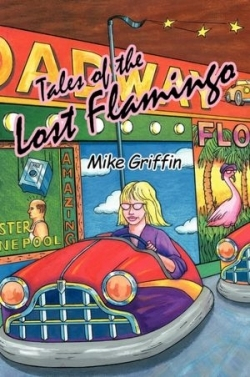Tales of the Lost Flamingo
Mike Griffin’s Tales of the Lost Flamingo challenges readers to determine where reality ends and fantasy starts. This includes the author’s bio, which states that the book was thirty-three years in the making, and Griffin expects his current novel-in-progress to be finished by 2045.
The twelve tales in this collection of short stories feature recurring characters and take place, with one exception, between the 1950s and 2030. The first stories concern Chester Cranepool, who begins life as an ignored child and develops incomparable talents as an adult. Attention shifts in subsequent stories to other characters, including a peripatetic artist, an actor named Lamar “the Star” Fandango (whose narrative shines with clever word play on “star”), and a drunken, party-loving sculptor. The stories conclude with developments in Cranepool’s later life and demise.
Pathos more than humor defines a story called “Happy Birthday Billy Willow.” Soldiers guarding a territory they believe to be free of Vietcong are divided into pairs. The routine consists of holing up in bunkers all day and going out on patrol at night. Griffin foreshadows the outcome of their return from an uneventful patrol by writing, “The coming of the gray-red dawn brought a feeling of lightheartedness to the men… . To everyone but Sergeant Buck, the patrol was over.”
“Happy Hour” describes the regulars at a convivial bar in Sarasota, Florida. Alan McDowell, the owner, enjoys the camaraderie of his diverse mix of patrons, especially sixty-year-old Mr. Chaney, who arrives punctually to occupy the same bar stool each night. When this regular doesn’t show up for several weeks, Al learns of Chaney’s death: “Holding back the tears, he walked into the dining room and took the ‘RESERVED’ sign off of the back table and placed it on the bar in front of Mr. Chaneys empty stool.”
The author moves on to “The Legend of Captain Bowfin A. Griffin,” which may or may not be true. Before he became a famous writer, Herman Melville met Captain Griffin in 1846, and together they took a boat deep into the Okefenokee Swamp in search of the elusive white mudfish. Only Melville survived this risky, inebriated adventure, and from it, so the story goes, he gained inspiration to write Moby Dick.
Griffin’s fantastic plots and goofy humor combine effectively with charismatic characters and their foibles. His stories emphasize the endurance of creative spirit through the use of skillfully written analogies and turns of phrase. Some readers may tire of his fondness for alliteration. There are minor editing errors, such as “retro-spective” instead of retrospective.
Griffin’s riffs on both the magical and tragic experiences of human existence should surprise and delight many readers, particularly those who enjoy fantasy novels and tall tales in the vein of Paul Bunyan stories.
Reviewed by
Margaret Cullison
Disclosure: This article is not an endorsement, but a review. The publisher of this book provided free copies of the book and paid a small fee to have their book reviewed by a professional reviewer. Foreword Reviews and Clarion Reviews make no guarantee that the publisher will receive a positive review. Foreword Magazine, Inc. is disclosing this in accordance with the Federal Trade Commission’s 16 CFR, Part 255.

